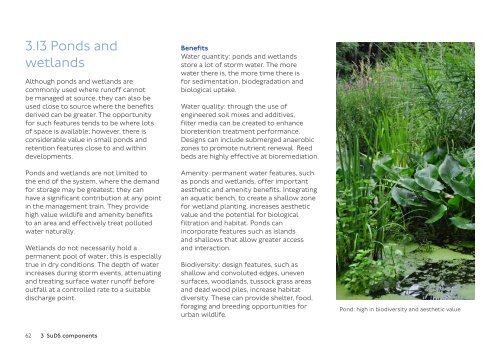SuDS in London - a guide
sustainable-urban-drainage-november-2016
sustainable-urban-drainage-november-2016
You also want an ePaper? Increase the reach of your titles
YUMPU automatically turns print PDFs into web optimized ePapers that Google loves.
3.13 Ponds and<br />
wetlands<br />
Although ponds and wetlands are<br />
commonly used where runoff cannot<br />
be managed at source, they can also be<br />
used close to source where the benefits<br />
derived can be greater. The opportunity<br />
for such features tends to be where lots<br />
of space is available; however, there is<br />
considerable value <strong>in</strong> small ponds and<br />
retention features close to and with<strong>in</strong><br />
developments.<br />
Ponds and wetlands are not limited to<br />
the end of the system, where the demand<br />
for storage may be greatest; they can<br />
have a significant contribution at any po<strong>in</strong>t<br />
<strong>in</strong> the management tra<strong>in</strong>. They provide<br />
high value wildlife and amenity benefits<br />
to an area and effectively treat polluted<br />
water naturally.<br />
Wetlands do not necessarily hold a<br />
permanent pool of water; this is especially<br />
true <strong>in</strong> dry conditions. The depth of water<br />
<strong>in</strong>creases dur<strong>in</strong>g storm events, attenuat<strong>in</strong>g<br />
and treat<strong>in</strong>g surface water runoff before<br />
outfall at a controlled rate to a suitable<br />
discharge po<strong>in</strong>t.<br />
Benefits<br />
Water quantity: ponds and wetlands<br />
store a lot of storm water. The more<br />
water there is, the more time there is<br />
for sedimentation, biodegradation and<br />
biological uptake.<br />
Water quality: through the use of<br />
eng<strong>in</strong>eered soil mixes and additives,<br />
filter media can be created to enhance<br />
bioretention treatment performance.<br />
Designs can <strong>in</strong>clude submerged anaerobic<br />
zones to promote nutrient renewal. Reed<br />
beds are highly effective at bioremediation.<br />
Amenity: permanent water features, such<br />
as ponds and wetlands, offer important<br />
aesthetic and amenity benefits. Integrat<strong>in</strong>g<br />
an aquatic bench, to create a shallow zone<br />
for wetland plant<strong>in</strong>g, <strong>in</strong>creases aesthetic<br />
value and the potential for biological<br />
filtration and habitat. Ponds can<br />
<strong>in</strong>corporate features such as islands<br />
and shallows that allow greater access<br />
and <strong>in</strong>teraction.<br />
Biodiversity: design features, such as<br />
shallow and convoluted edges, uneven<br />
surfaces, woodlands, tussock grass areas<br />
and dead wood piles, <strong>in</strong>crease habitat<br />
diversity. These can provide shelter, food,<br />
forag<strong>in</strong>g and breed<strong>in</strong>g opportunities for<br />
urban wildlife.<br />
Pond: high <strong>in</strong> biodiversity and aesthetic value<br />
62 3 <strong>SuDS</strong> components


